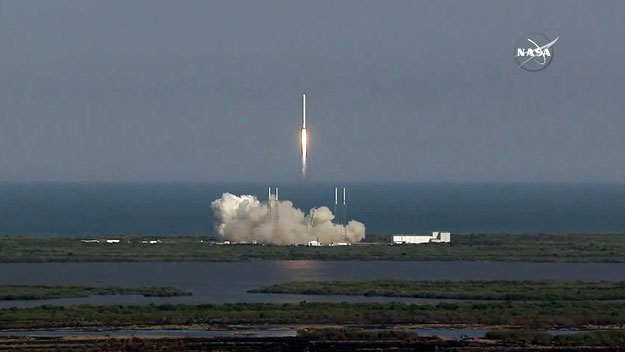SpaceX Launches Hardware From CU, Lands Rocket At Sea
CAPE CANAVERAL, Fla. (AP/CBS4) — SpaceX resumed station deliveries for NASA on Friday, and in a double triumph, successfully landed its booster rocket on an ocean platform for the first time.
The unmanned Falcon rocket soared into a clear afternoon sky, carrying a full load of supplies for the International Space Station as well as a futuristic pop-up room.
High-tech hardware designed and built at the University of Colorado Boulder was on board. Developed by BioServe Space Technologies headquartered in CU-Boulder's Department of Aerospace Engineering Sciences, the hardware will support four biomedical experiments, said BioServe Associate Director Stefanie Countryman.

After sending the Dragon capsule on its way, the first-stage booster peeled away. Instead of dropping into the Atlantic like leftover junk, the 15-story booster steered to an upright touchdown on the barge, withstanding 50 mph gusts. Engines slowed its descent, supporting legs popped out and the final touchdown appeared neat and clean.
"The rocket landed instead of putting a hole in the ship — or tipping over — so we're really excited about that," SpaceX founder and chief executive Elon Musk told reporters at the Florida launch site.
His employees gathered outside the company's glassed-in mission control in Hawthorne, California, cheered wildly, jumped up and down, and chanted, "USA, USA, USA!" when the booster touched down. President Barack Obama later chimed in via Twitter, praising SpaceX as an innovator.
Bigelow Aerospace, the Nevada company behind the equally innovative inflatable compartment bound for the space station, offered congratulations for the "beautiful launch and barge landing."
Although SpaceX managed to land a spent booster rocket on the ground at Cape Canaveral in December, touchdowns at sea had proven elusive, with several attempts over the past year ending in explosions on the barge.
Musk's goal is to make rockets as reusable as airplanes and as cost-effective, too. He hopes to reuse this particular booster in June on another orbital flight, following 10 test firings on the pad.
LINK: Watch The Launch & Landing
SpaceX stands to save tens of millions of dollars per flight, Musk said, by recycling the boosters. He's looking forward to the day when booster landings become boring: "So when it's like, 'Oh yeah, another landing, OK, no news there.' That's actually when it will be successful."
Sea touchdowns are actually quite tricky, Musk said, since the targets are relatively small — about the size of a football field — and bobbing in the waves. The boosters will need to land at sea, versus the shore, when they are traveling too fast and using too much fuel to get their spacecraft into super-high orbits — or out of Earth's orbit altogether.
Blue Origin, run by another high-tech billionaire, Jeff Bezos, successfully has landed his rockets in West Texas in recent months, but those flights were suborbital and therefore not flying nearly as fast or high as the SpaceX Falcon.
This marks SpaceX's first shipment for the space station in a year. Its last delivery attempt in June ended in flames after just two minutes, doomed by a snapped strut in the oxygen tank of the upper stage. The company resumed Falcon launches late last year with satellites.
The Dragon and its 7,000 pounds of freight — including the attention-grabbing payload — should reach the space station Sunday.
Bigelow Aerospace's expandable compartment will swell to the size of a small bedroom, once inflated next month. It's a testbed for orbiting rental property that the Nevada company hopes to launch in four years, and also for moon and Mars habitats.
Traffic has been heavy lately at the 260-mile-high complex. NASA's other commercial shipper, Orbital ATK, made a delivery at the end of March, then Russia just last weekend. SpaceX's Dragon will join three cargo carriers and two crew capsules already parked there.
Besides a bevy of biological experiments — including 20 mice for a muscle study, and cabbage and lettuce plants for research as well as crew consumption — the Dragon capsule holds the pioneering pod.
The Bigelow Expandable Activity Module, or BEAM, will be attached to the space station in about a week, but won't be inflated until the end of May.
BEAM is a 21st-century reincarnation of NASA's TransHab, which never got beyond blueprints and ground mock-ups in the 1990s. Hotel entrepreneur Robert Bigelow bought rights to TransHab, then persuaded NASA to host BEAM at the space station.
Empty except for sensors, the experimental BEAM is Bigelow's first soft-sided space structure meant for people. Astronauts will enter periodically during the two years it's at the station.
Bigelow hopes to have two station-size inflatables ready to launch around 2020 for commercial use, potentially followed by inflatable moon bases. NASA, meanwhile, envisions using inflatable habitats during 2030s Mars expeditions.
On the eve of the launch, Bigelow said the mission promises to "change the entire dynamic for human habitation."
As does the booster landing for the future of spaceflight, Musk said.
"It's another step toward the stars. In order for us to really open up access to space, we've got to achieve full and rapid reusability," he said.
Musk said it will take a few years to make the landing process smooth and efficient, and failures likely will occur, "but I think it's proven that it can work."
LINKS: SpaceX | Bigelow Aerospace | NASA
- By MARCIA DUNN, AP Aerospace Writer
(TM and © Copyright 2016 CBS Radio Inc. and its relevant subsidiaries. CBS RADIO and EYE Logo TM and Copyright 2016 CBS Broadcasting Inc. Used under license. All Rights Reserved. This material may not be published, broadcast, rewritten, or redistributed. The Associated Press contributed to this report.)



